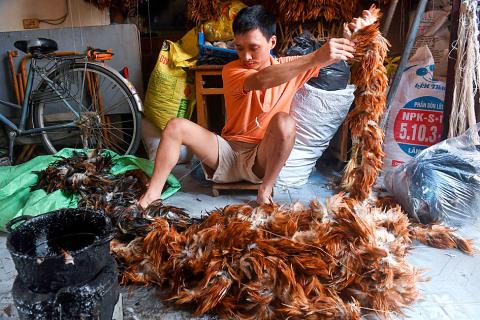Fluffy, soft and easy to buy off the back of a bike: Vietnam’s chicken feather dusters have ruled the roost for generations, but artisans fear for their future as buyers turn to cheaper alternatives.
The dusters, ubiquitous across the country’s leafy capital, have long been a staple in Vietnamese homes to clear cobwebs from ancestral altars or hard-to-reach corners of the house.
However, cheap synthetic dusters have flooded the market — the latest influx of mass-produced goods to chip away at the profits of traditional artisans.

Photo: AFP
“We don’t earn as much money as we could in other jobs, but I do this job to keep my family tradition alive,” 36-year-old Nguyen Huy Tho told reporters near his stuffy garage, filled with hanging lines of feather plumes.
His family has been making dusters for more than a century, and unlike his five sisters who all work in office jobs or as teachers, he decided to follow in his father’s footsteps after graduating from college.
It was once a soaring trade. Tho used to earn about US$350 per month selling the dusters, but today profits are down by one-third.
His 85-year-old grandfather, who still helps out on occasion, said many young people are now looking for better-paying jobs.
“Most people now think about earning good money, but this job is tedious, like making a toothpick,” Nguyen Huy De told reporters.
Each duster takes about two hours to make, and they sell on the streets of Hanoi for about US$7. Traditionally, families sold feathers to door-to-door collectors after a chicken feast, with sales spiking around traditional holidays.
Today Tho’s family buys feathers from chicken wholesalers, as the duty of killing chickens has mostly moved out of the home.
Even though the feathers are easier to find, there are only about 10 families still making the dusters in Tho’s Trieu Khuc village on the outskirts of Hanoi, once a renowned hub for the trade.
It is not just families such as Tho’s feeling the squeeze.
Vendor Nguyen Minh Quang said sales have dipped in recent years, but he still cycles 50km into Hanoi daily to peddle the dusters.
“Now that there are plastic dusters in the market, fewer traditional feather dusters are sold. I don’t get much money selling them, and I get really tired cycling to Hanoi every day,” he said.

Taiwanese suppliers to Taiwan Semiconductor Manufacturing Co. (TSMC, 台積電) are expected to follow the contract chipmaker’s step to invest in the US, but their relocation may be seven to eight years away, Minister of Economic Affairs J.W. Kuo (郭智輝) said yesterday. When asked by opposition Chinese Nationalist Party (KMT) Legislator Niu Hsu-ting (牛煦庭) in the legislature about growing concerns that TSMC’s huge investments in the US will prompt its suppliers to follow suit, Kuo said based on the chipmaker’s current limited production volume, it is unlikely to lead its supply chain to go there for now. “Unless TSMC completes its planned six

Power supply and electronic components maker Delta Electronics Inc (台達電) yesterday said second-quarter revenue is expected to surpass the first quarter, which rose 30 percent year-on-year to NT$118.92 billion (US$3.71 billion). Revenue this quarter is likely to grow, as US clients have front-loaded orders ahead of US President Donald Trump’s planned tariffs on Taiwanese goods, Delta chairman Ping Cheng (鄭平) said at an earnings conference in Taipei, referring to the 90-day pause in tariff implementation Trump announced on April 9. While situations in the third and fourth quarters remain unclear, “We will not halt our long-term deployments and do not plan to

‘SHORT TERM’: The local currency would likely remain strong in the near term, driven by anticipated US trade pressure, capital inflows and expectations of a US Fed rate cut The US dollar is expected to fall below NT$30 in the near term, as traders anticipate increased pressure from Washington for Taiwan to allow the New Taiwan dollar to appreciate, Cathay United Bank (國泰世華銀行) chief economist Lin Chi-chao (林啟超) said. Following a sharp drop in the greenback against the NT dollar on Friday, Lin told the Central News Agency that the local currency is likely to remain strong in the short term, driven in part by market psychology surrounding anticipated US policy pressure. On Friday, the US dollar fell NT$0.953, or 3.07 percent, closing at NT$31.064 — its lowest level since Jan.

The New Taiwan dollar and Taiwanese stocks surged on signs that trade tensions between the world’s top two economies might start easing and as US tech earnings boosted the outlook of the nation’s semiconductor exports. The NT dollar strengthened as much as 3.8 percent versus the US dollar to 30.815, the biggest intraday gain since January 2011, closing at NT$31.064. The benchmark TAIEX jumped 2.73 percent to outperform the region’s equity gauges. Outlook for global trade improved after China said it is assessing possible trade talks with the US, providing a boost for the nation’s currency and shares. As the NT dollar